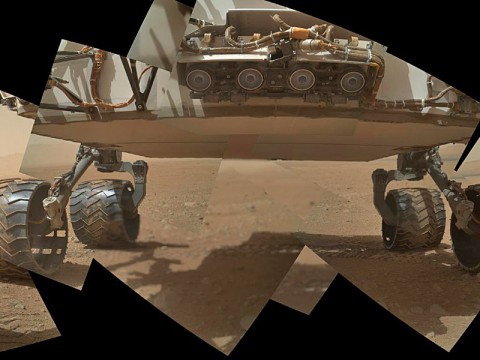Written by Guy Webster
NASA’s Jet Propulsion Laboratory
 Pasadena, CA – NASA’s Mars rover Curiosity stepped through activities on September 7th, 8th and 9th designed to check and characterize precision movements by the rover’s robotic arm and use of tools on the arm.
Pasadena, CA – NASA’s Mars rover Curiosity stepped through activities on September 7th, 8th and 9th designed to check and characterize precision movements by the rover’s robotic arm and use of tools on the arm.
The activities confirmed good health and usefulness of Mars Hand Lens Imager, or MAHLI, and used that camera to check arm placement during several positioning activities.

“Wow, seeing these images after all the tremendous hard work that has gone into making them possible is a profoundly emotional moment,” said MAHLI Principal Investigator Ken Edgett of Malin Space Science Systems, San Diego, CA. “It is so exciting to see the camera returning beautiful, sharp images from Mars.”
Selected MAHLI images, with captions, are available at: http://1.usa.gov/PecY9c . Raw versions of all MAHLI images are available along with raw images from the other cameras on Curiosity at: http://mars.jpl.nasa.gov/msl/multimedia/raw/ .

The camera’s calibration target includes a 1909 Lincoln penny that Edgett purchased for this purpose. “We’re seeing the penny in the foreground and, looking past it, a setting I’m sure the people who minted these coins never imagined,” Edgett said.
“The folks who drive the rover’s arm and turret have taken a 220-pound arm through some very complex tai chi, to center a penny in an image that’s only a few centimeters across,” said MAHLI Deputy Principal Investigator Aileen Yingst of the Tucson-based Planetary Science Institute. “They make the impossible look easy.”
The arm characterization activities, including more imaging by MAHLI, will continue for a few days before Curiosity resumes driving toward a mid-term science destination area called Glenelg. In that area, the rover may use its scoop to collect a soil sample, and later its drill to collect a sample of powder from inside a rock.

Curiosity is five weeks into a two-year prime mission on Mars. It will use 10 science instruments to assess whether the selected study area ever has offered environmental conditions favorable for microbial life. NASA’s Jet Propulsion Laboratory, a division of the California Institute of Technology in Pasadena, CA, manages the mission for NASA’s Science Mission Directorate in Washington.
More information about Curiosity is online at: http://www.jpl.nasa.gov/msl , http://www.nasa.gov/msl and http://mars.jpl.nasa.gov/msl . You can follow the mission on Facebook and on Twitter at: http://www.facebook.com/marscuriosity and http://www.twitter.com/marscuriosity .


